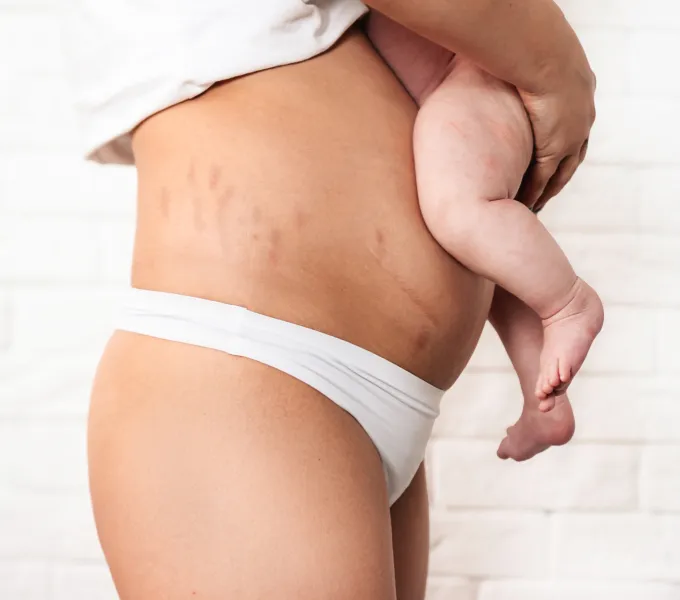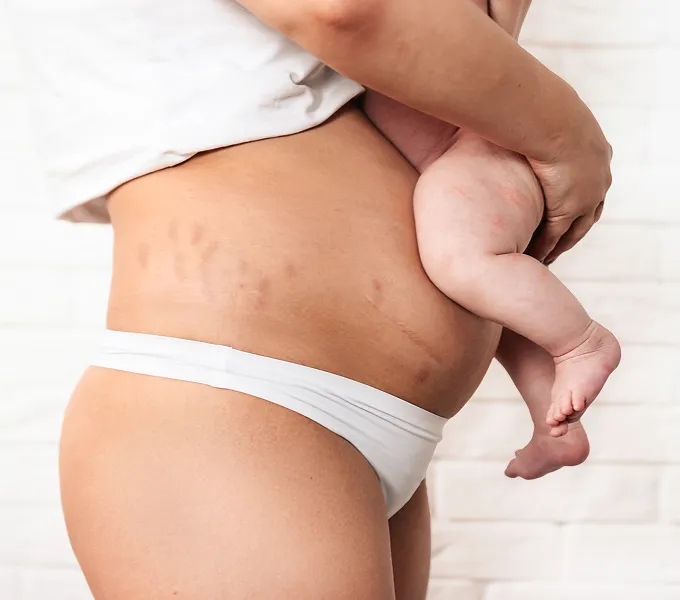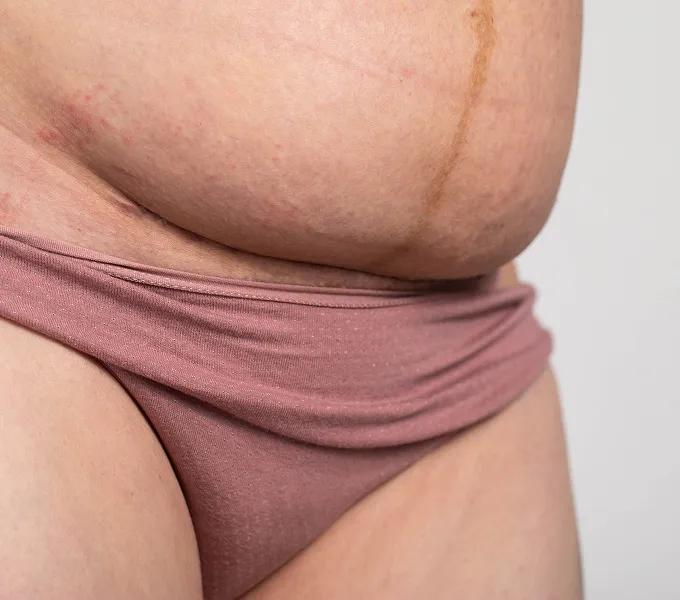
How to Care for Your C-Section Scar to Prevent Pain & Discomfort
If you're one of over a million mothers who deliver via c-section every year, you brought home something else that requires love and attention; your incision. A c-section incision — and the scar that remains — can be a beautiful emblem of motherhood, and it can also be a reminder of a difficult or even traumatic experience.
It’s normal to feel sensitive about your scar, even decades after childbirth, especially if your c-section wasn’t planned. Some women report that any sensation near their scar elicits a strong emotional response, which makes them want to avoid contact with the area altogether. To stay connected to your body and feel your best, now and in the future, learning to care for your scar is an important part of your recovery.
How a C-Section Incision is Made & Closed
During a c-section, your doctor makes a series of incisions through your abdomen. The first is through the skin, fat, and fascia covering your lower abdominal muscle. The lower abdominal muscle can usually be moved aside, but in rare cases it must also be cut. The next incision is through your peritoneum, the membrane lining your abdomen. Finally, your doctor makes an incision in your uterus to deliver the baby.
Usually, the first cut is a low transverse incision, just above the pubic bone (a “bikini cut”). In complicated or urgent deliveries, your doctor may choose a vertical incision instead.
After your baby is out of your belly, your doctor will close each incision using one or more of these techniques:
- Dissolvable stitches: made of materials your body can absorb, these are used to close your uterine incision and dissolve naturally
- Surgical stitches: aka “sutures,” these are made of plastic or nylon and must be removed 3-5 days later by your doctor
- Staples: made of titanium, these are sometimes used to close the outer incision and must be removed 3-10 days later by your doctor
- Surgical glue: this may be applied to your outer incision in lieu of or in addition to other closure methods to create a seal
Caring For Your Incision
Typical incision care instructions include directions like these:
- Gently cleanse the area daily with soap and water.
- Wear loose-fitting clothing.
- Monitor for signs of infection like fever, discharge, or irritation.
- Expect some pain, itching, hypersensitivity, and numbness around your scar. Ask your doctor about the right pain management strategies for you in the weeks following delivery.
- Avoid any physical activity beyond lifting your baby until you are cleared by our OB. This includes heavy lifting, long hours on your feet, core exercises, or movements that may strain the area around your scar.
- Wait to have sex until you are cleared by our OB — and, of course, until you feel genuinely ready!
Follow your doctor’s instructions and let them know how you're feeling as your incision heals. For a more detailed guide to care after a c-section, check out the Mayo Clinic’s documentation.
How Your Scar is Formed
After your doctor closes up your incision, your body begins a healing process that lasts about 6 weeks.
- First, your body works to stop any active bleeding using the platelets in your blood, which stick together to seal off broken blood vessels. These blood vessels leak a substance called transudate, a solution of mostly water and salt that fills the wounded area with fluid to help protect against infection and makes it easy for your white blood cells to arrive quickly.
- After this initial inflammation comes down, your body begins to build new tissue using collagen proteins to repair your wound. Collagen is thick, strong, and relatively inflexible in comparison to your regular skin cells. It may give your scar a raised or darkened appearance.
- On the surface, your scar will likely be 4 to 8 inches long and appear pink, red, purple, or brown depending on your skin tone. It may flatten and shrink naturally over time.
- If you have a darker skin tone or a family history of abnormal wound healing, you may be more prone to forming hypertrophic or keloid scars. These scars are characterized by significant deposits of dark, hardened or raised tissue around the wound site and have much less flexibility than the surrounding skin.
- Some people notice a fleshy bulge that sits on top of their c-section scar (sometimes called a “c-section shelf”). This pouch contains fat, loose skin, and scar tissue that collects above the incision, after it heals.
- Beneath your skin, you can develop scar tissue wherever an incision was made. This extra tissue may cause complications you might not initially guess were related to your scar, including lower back pain, hip and pelvic pain, painful sex, constipation, and bladder frequency, urgency, or spasms.
How to Prevent and Treat C-Section Scar Pain & Discomfort
Whether your scar is recent or not-so-recent, it’s never too late to care for it. Here are some things you can do:
- Get familiar with your scar. Lightly stroking, tapping, and rubbing the area can help with nerve regrowth and reduce numbness, and is an important first step towards reconnecting with this area of your body.
- Try physical therapy as soon as 3 weeks post-delivery (or when your incision is fully closed). At Origin, our therapists combine techniques like manual scar mobilization, cupping, heat, and cold laser therapy to improve pain, stiffness, and other symptoms related to your scar. They can help you safely re-engage your abdominal muscles, help your fascia recover, and teach you to perform at-home massage to continue healing your scar tissue.
- Ease into exercise. At Origin, we create therapeutic exercise programs designed specifically for you to heal safely and build strength so you can feel confident about getting moving again.




